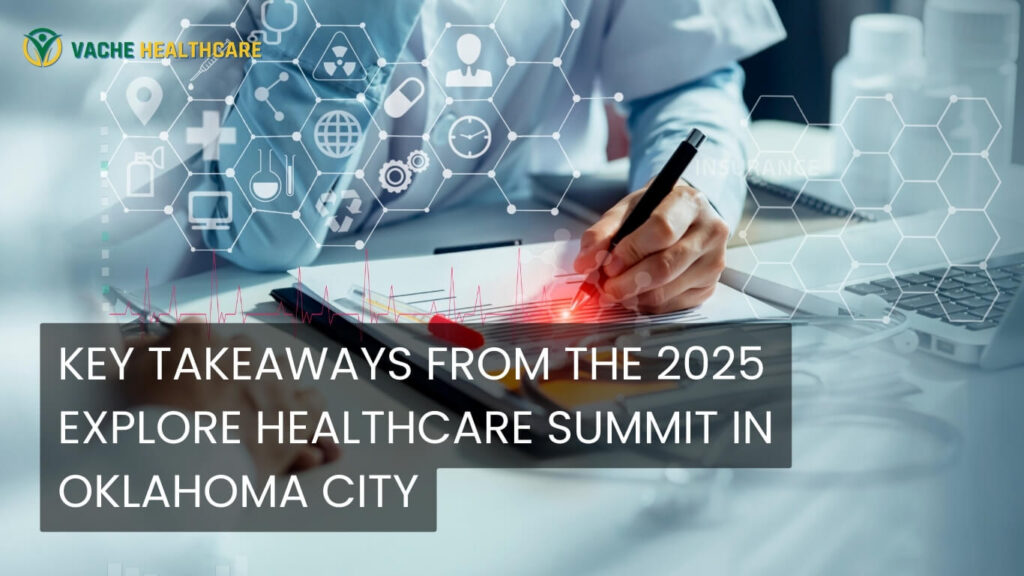The EXPLORE Healthcare Summit 2025 held in Oklahoma City proved to be a pivotal gathering for healthcare professionals, policy makers, insurers, and technology leaders. As one of the most anticipated Oklahoma City events this year, the summit brought together innovators and thought leaders to discuss the challenges and opportunities shaping the future of care delivery across the region and the nation.
This year’s summit placed a strong emphasis on collaborative solutions, emphasizing the need for systems that are more efficient, accessible, and prepared for future crises. From healthcare innovations to strategic insurance reforms, the conversations set the tone for a more integrated and tech-enabled healthcare ecosystem.
As the industry grapples with increasing demand, rising costs, and the ongoing transformation of patient expectations, the summit served not only as a platform for ideas but as a roadmap for what lies ahead.
Spotlight on Healthcare Innovation
Innovation took center stage at the Healthcare Summit 2025, where emerging technologies and patient-centric models were showcased as key drivers of transformation. Industry leaders presented groundbreaking tools designed to improve diagnostics, streamline care coordination, and personalize treatment plans.
From AI-assisted imaging systems to wearable health trackers that transmit real-time data to physicians, the summit highlighted a clear shift toward smarter, faster, and more responsive healthcare.
Several startups and established companies demonstrated how machine learning and predictive analytics are being used to enhance early detection of chronic diseases and optimize hospital workflows. These healthcare innovations are not just about technology—they’re about delivering better outcomes, reducing costs, and making healthcare more accessible to patients across Oklahoma and beyond.
The summit reinforced that innovation must be both practical and inclusive, ensuring that advancements reach urban hospitals and rural clinics alike. In an age where health equity is a growing priority, the emphasis is on scalable solutions that benefit every patient, regardless of their zip code.
Advancements in Telehealth Services
One of the most talked-about developments at the summit was the evolution of virtual care. Panel discussions and case studies made it clear that telehealth advancements are no longer just temporary solutions—they’re becoming a foundational part of how healthcare is delivered across the country.
Healthcare systems shared data showing increased patient satisfaction and lower appointment no-show rates thanks to virtual consultations. More importantly, rural providers discussed how telehealth has closed access gaps, allowing patients in underserved areas to connect with specialists without long travel times.
Innovations in remote patient monitoring, mental health services, and chronic disease management through digital platforms were also highlighted as essential tools for future-ready care.
The conversations emphasized that telehealth is evolving from a convenience to a necessity, especially as providers look to maintain continuity of care during emergencies, improve flexibility, and reach broader populations. As regulations continue to adapt, these solutions are expected to expand further, offering even greater support to patients across Oklahoma.
Insurance Industry Trends from the Summit
The Healthcare Summit 2025 also spotlighted key shifts in the insurance landscape, with providers, regulators, and policy experts addressing how evolving patient needs are driving changes in plan structures and benefits. Among the most notable insurance trends discussed was the push for more flexible and personalized coverage options that reflect modern healthcare realities.
Insurers are responding to a growing demand for plans that integrate virtual care access, mental health support, and comprehensive post-hospitalization services. Attendees noted that consumers are more informed and selective, prompting insurers to simplify plan language, enhance digital tools, and offer greater price transparency.
There was also a strong focus on value-based care models, where reimbursement is tied to patient outcomes rather than the volume of services provided. These models are being tested across Oklahoma and have shown promise in improving care quality while controlling costs.
In all, the summit made clear that the insurance sector is not standing still. It’s adapting rapidly to align with a more proactive, tech-enabled, and patient-first healthcare environment.
The Rising Importance of Critical Illness Coverage
With rising healthcare costs and increasing awareness of long-term health risks, critical illness coverage emerged as a major focus at this year’s summit. Speakers emphasized how this form of insurance is evolving from an optional add-on to a financial safety net that more individuals are beginning to prioritize.
The summit highlighted alarming trends around the growing prevalence of serious health conditions like heart disease, stroke, and cancer, many of which come with substantial out-of-pocket costs even for those with standard insurance plans. Critical illness policies help bridge that gap, offering lump-sum payouts that can cover lost income, treatment expenses, or even home adjustments following a diagnosis.
Industry professionals agreed that educating consumers on the benefits of this coverage will be key to broader adoption. As healthcare continues to shift toward early detection and prevention, having coverage that protects against financially devastating illnesses is no longer just smart—it’s necessary.
In a state like Oklahoma, where access to specialized care can vary greatly by location, this type of protection offers peace of mind and financial resilience in times of health crises.

Enhancing Dental and Vision Insurance Access
Another standout theme at the summit was the call to improve access to dental and vision insurance, two areas of coverage often overlooked in broader healthcare discussions. Experts pointed out that poor oral and eye health can contribute to more serious systemic issues, including heart disease, diabetes complications, and cognitive decline.
Many panelists stressed the importance of treating dental and vision care as essential, not optional. Employers, insurers, and health advocates alike are working to design plans that include these services as core benefits, particularly for underserved communities and seniors. There was also an emphasis on expanding mobile clinics and school-based programs to deliver preventive care directly where it’s needed most.
Speakers underscored the role of public-private partnerships in broadening access and eliminating barriers to routine dental and vision checkups. With affordability and convenience becoming top priorities, these discussions made it clear that future insurance models must treat oral and visual health as integral parts of overall wellness.
Key Policy and Regulatory Updates Discussed
Policymakers and healthcare administrators used the summit as a platform to unpack upcoming changes to healthcare laws and regulations. Several discussions focused on how state and federal agencies are working to modernize healthcare frameworks to reflect rapid technological and demographic changes.
Key updates included proposed adjustments to telehealth reimbursement policies, with new guidelines aiming to make virtual care more accessible and financially sustainable. Licensing reforms were also highlighted, especially initiatives to allow cross-state practice for certain medical professionals—a move intended to ease provider shortages in rural areas.
Regulators spoke about improving consumer protections, particularly around surprise billing and coverage transparency. There was also conversation around streamlining the process for updating insurance plan benefits to ensure they keep pace with medical innovations and patient needs.
These policy shifts are designed to support a more flexible, inclusive, and patient-focused healthcare system, aligning with the broader goals shared throughout the Healthcare Summit 2025.
Community Health Initiatives and Collaborations
Beyond technology and policy, the summit also shone a light on grassroots efforts and local partnerships that are driving real change at the community level. Healthcare leaders across Oklahoma shared how collaboration between hospitals, nonprofits, and local governments is improving access and outcomes, especially in historically underserved areas.
Several successful pilot programs were discussed, including mobile health units offering screenings in remote towns and wellness outreach initiatives aimed at addressing food insecurity and chronic disease prevention. These programs emphasize that health doesn’t begin and end in a clinic—it starts in neighborhoods, workplaces, and schools.
Attendees stressed the need for continued investment in preventive care and education to reduce long-term healthcare costs. Stronger community relationships were cited as essential to tackling broader public health challenges and creating lasting change. These local partnerships are now seen as a powerful complement to system-wide innovation, helping ensure that progress reaches everyone, not just those with the most access.
Coleen Vache’s Insights and Strategic Takeaways

As a participant in the Healthcare Summit 2025, Coleen Vache Healthcare offered valuable insight into how small, agile insurance providers are uniquely positioned to adapt to the evolving healthcare landscape. The brand emphasized its commitment to not just keeping pace with industry changes but to leading with client-first strategies that address real-world concerns.
Key takeaways included the need for more proactive communication around benefit changes, especially as telehealth advancements and critical illness coverage become essential parts of everyday healthcare planning. Coleen Vache Healthcare also highlighted the importance of flexibility in plan offerings, particularly in areas like dental and vision insurance, where demand for accessible, affordable options continues to rise.
By staying closely aligned with both policy shifts and patient expectations, the brand reaffirmed its mission to deliver health coverage that is responsive, transparent, and supportive during moments that matter most. Their participation in the summit underscored the value of smaller firms having a voice at the table, bringing real community insight into broader industry dialogue.
Conclusion: What the Future Holds Post-Summit
The EXPLORE Healthcare Summit 2025 made it clear: the future of healthcare in Oklahoma and beyond is being shaped by innovation, collaboration, and a renewed focus on accessibility. From AI-driven diagnostics and telehealth advancements to smarter insurance models and expanded preventive care, the summit highlighted how quickly the industry is evolving—and how essential it is for providers and insurers to evolve with it.
For residents of Oklahoma City and across the state, the conversations sparked at this event are more than theoretical. They’re the groundwork for real changes in how care is delivered, how policies are structured, and how communities stay healthy.
Whether it’s through new critical illness coverage options, better access to dental and vision insurance, or community-driven health programs, the momentum from this summit is expected to carry forward well beyond 2025.
As healthcare systems modernize and regulations adapt, organizations like Coleen Vache Healthcare will continue to play a vital role in helping individuals and families navigate a changing landscape with confidence and clarity.
Frequently Asked Questions
What is the EXPLORE Healthcare Summit, and who attends it?
The EXPLORE Healthcare Summit is an annual gathering of healthcare professionals, insurers, policy makers, and innovators. It serves as a platform to discuss industry trends, policy updates, and the future of healthcare delivery.
What were the key healthcare innovations discussed in 2025?
Highlights included AI-powered diagnostic tools, wearable health monitors, personalized treatment platforms, and improved systems for data sharing across providers to streamline patient care.
How is telehealth evolving based on the summit insights?
Telehealth is transitioning from a temporary solution to a long-term pillar of healthcare. The summit emphasized its expanding role in chronic care, mental health, and rural access, supported by regulatory improvements and broader insurance acceptance.
Are there new trends in insurance coverage shared at the event?
Yes, insurers are shifting toward more flexible, consumer-focused plans that include digital health tools, mental health services, and better integration of preventive care, reflecting broader insurance trends across the country.
Why is critical illness coverage gaining attention in 2025?
With rising rates of chronic disease and unexpected health events, critical illness policies offer vital financial protection. They help cover out-of-pocket expenses and income loss during recovery, making them increasingly essential.
How is Coleen Vache responding to the trends from the summit?
Coleen Vache Healthcare is aligning its offerings with emerging trends by enhancing coverage flexibility, supporting telehealth options, and emphasizing transparent communication with clients to meet evolving healthcare needs.
Where can I learn more about updated insurance plans in Oklahoma City?
You can visit local providers, check with your employer’s HR department, or explore online resources to compare the latest insurance options. For personalized assistance, reach out to trusted names like Coleen Vache Healthcare for updated offerings in your area.








